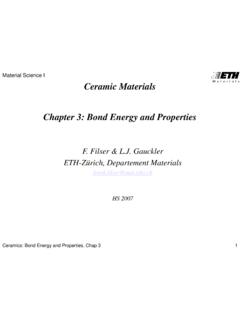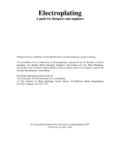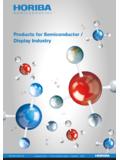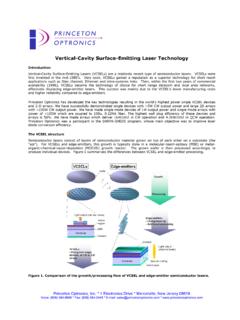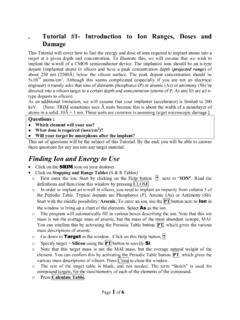Transcription of Introduction to FIB SEM - Nonmetallic Inorganic …
1 1 Introduction to FIB SEM Basic Physics and ApplicationsJoakim Reuteler, Nonmetallic Inorganic Materials2 FIB SEM is a NANOLABORATORY31. Ga+source: LMIS2. A combined Focused Ion Beam (FIB) Scanning Electron Microscope (SEM) CrossBeam NVision 40 from Carl Zeiss SMT3. Micromanipulator MM3A from Kleindiek4. Applications Cross Section (CS) the basic skill! TEM lamella preparation Deposition and Milling with feature mill 5. Outlook and LiteratureOutline41. Ga+source: LMISG ilbert (1600) fluid under high tension forms a cone Gilbert cone even a thin thread can be sprayed out (jet)Taylor (1964) exactly conical solution to equations of Electro Hydro Dynamics (EHD) Taylor cone experimentally confirmed the conical shape Taylor Gilbert Kolloquium on Dec 19, Yarin: Electrospraying ofNanofibres and Nanotubes Gilbert was the scientist (and probably lover of) Queen Elisabeth I, she was very fond of physical Ga+source: LMISL iquid Metal Ion Source (LMIS) Gabeam formed at the apex of Taylor Gilbert cone very high spacial coherence, focussable beam!
2 Why Ga? melting point at 30 C liquid around room temperature low steam pressure appliccable in HV [Ga2+]/[Ga+] ~ 10 4at 10 m narrow energy distributioncoil for heating, also serves as Ga reservoirblunt W with grated surface for Ga transportGa forms a Taylor Gilbert cone1 m62. A combined microscopecoincidence pointWD = 5 mm54 FIBcolumnSEMcolumngas injectionnozzelsample at 54 tiltvacuum chamberfully motorized stagetubing forgas Focused Ion Beam (FIB)generation of beam(2 A)adjusting the current(typically pA to nA)scanning the beamIon column Ga+source (LMIS) ion optics (electrostatic lenses) fast beam blanker(electrostatic) different currents(aperture stripe) adjustable acceleration Focused Ion Beam (FIB) SMALL CURRENT NARROW BEAM Beam tails can extend up to some mprobe spot[Ga+]distancebeam Focused Ion Beam (FIB).
3 Interaction with sampleGa+beam hits substrate and yields secondary electrons sputterd atoms and ions implantation of Ga amorphisation /recrystallization3 FIBing modes : imaging, milling and depositionhappen simultaneously ion current + atmosphere pronounce one aspect!2nd electronsGaatoms /ions from sampleimplanted ) implantation and amorphisation also occur at grazing ) Depth of damage layer depends also on energy of Ga+.30 kV Ga+ Impinging Ga+always mill a little bit and produce secondary electrons Sample surface is damaged more with increasing Ga+ Focused Ion Beam (FIB): imagingFIB imaging: impinging Ga+produce secondary electrons ET or InLens detector typically at 30 kV, 40 pA optimal resolution and signal other currents and energies different contrastAdvantages: channeling contrast removal of oxide layerDisadvantages: damage of a days there is scanning He microscopy high contrast highest resolutionSE image from scanning with FIB(30 kV, 40 pA)SE image from scanning with eBeam(3 kV, 120 um, hc) Focused Ion Beam (FIB): millingFIB as a nano scalpell.
4 Milling sputter process less damage at cutting surfacefor small currents resolution better for small current but high currents mill faster use series of decreasing currents redeposition (all in one layer gives a wedge) milling strategy is important ( milling mode / deposition mode ) dwell time! ( for ceramics) pixel fill factor 100 % is OK2nd electronsatoms /ions from samplesample30 kV Ga+30 kV Ga+milled trench and redeposited material!1st2nd3rdmilling Focused Ion Beam (FIB): depostionDeposition of material nozzel local gas atmosphere decomposition of precursor gas CVD ion current = Area x 5 pA/ m2 pixel fill factor = 40 70 %! short dwell time ( s for C, s for Pt) also possible to use e beam for depo 1 kV & slow scanning speed!
5 Deposited material: mixture of Ga, C and the depo speciesExamples of species that can be deposited:C, Pt, W, Pd, SiO2Ga+cracks precursor gassample30 kV Ga+deposited materialGIS nozzleprecursor adsorbson sample surface 30 kV Ga+ Deposited species is not pure: lots of Ga and C Deposition without surface damage only by eBeam Focused Ion Beam (FIB): enhanced millingEnhanced milling(etching) impinging Ga+knocks out atoms and ions from sample redeposition is prevented by chemical reaction with the adsorbed gas formation of volatile species etching gases that react only with certain species selective millingExamples of etching gasesXeF2 enhanced Si and insulator millingI2 enhanced metal millingH2O enhanced carbon (polymers.)
6 MillingGa+cracks precursor gas reactive atmospheresampleless or no redepositedmaterial in the trenchGIS nozzleprecursor adsorbson sample surface 30 kV Ga+30 kV Ga+ Focused Ion Beam (FIB): GIS nozzelsample incoincidence point150 mSEM pole pieceFIB pole pieceGIS nozzleRule:Only insert GIS nozzel, when sample is in coincidence point! Scanning Electron Microscope (SEM)EDX500 nmsemi-quantitative chemical informationX-RayEBSD15 nmcristallographic informationBSEEsB15 nmZ-contrastBSESE, InLens3 nmBest surface sensibilitySEDetectorResolution (typical)UseSignalSize of interaction volume depends on eBeamenergyand atomic numberof materialSEM probesizevsinteraction volume resolution imaging using several different signals Scanning Electron Microscope (SEM)Best resolution at 1 kV effectively 10 nm, for 20 kV maybe 5 nm.
7 Don t expect too much! Scanning Electron Microscope (SEM)Pecularities of working in a combined microscope working in coincidence point, WD 5 mm eBeam is less stable for low EHT working at 54 tilt samples look different than from top view! working with 120 m appertureand high currentmode really strong contrast, again samples look different than at normal settingsWhy all this? see same spot with SEM and FIB normal incidence for FIB simultaneous FIBing and SEMingSteve Reyntjens: Half of the rent of working with a Dual Beam is understanding the geometry! 1818 Load lockMicro manipulator controlGemini electron columnSII Zeta ion columnGas Injection System (GIS) CrossBeam NVision 40 from Carl Zeiss CrossBeam NVision 40 from Carl Zeiss SMT SEM: Gemini column deccelaration field (beam booster) inLens and EsB geometry selects electron energy typically adjust a lot for stigmatism construction problem: column valve position not idealEsB detectorInLens detectorgrid (0 kV)Rule:Leave microscope with open SEM colum valve!
8 Electrostatic lensmagnetic lensbeam booster(8 kV over set energy) CrossBeam NVision 40 from Carl Zeiss SMT FIB column: SII Zeta fixed number of appertures: 13 condensor allows to adjust current for each apperture in principle different sets of currents are possible adjustable acceleration voltage sets of currents for different voltages problem with stability of LMIS often need to heatIn Smart SEM: FIB control FIB imaging only with imaging current (typically 40 pA, 30 kV) FIB milling box is set in FIB image, column optics values are computed for the milling current from a list well aligned currents needed to avoid shifts! new program daily align adjust those currents that you will use that dayRule:Do not click auto extractor!
9 CrossBeam NVision 40 from Carl Zeiss SMT, Our FIB SEMO rganization System is part of EMEZ acknowledge support in publications System was partially financed by SNF acknowledge support Room: HPM A66 (33312) Technician: Philippe Gasser, HPT C 104 (36541)Booking no booking more than 2 weeks in advance 25 % from 8 am to 5 pm is reserved for EMEZ NMW, LNM, LMPT, MICRO have special access rights for the first 3years ( until June 2010) 75 % from 8 am to 5 pm together please don t waste the precious beam time! CrossBeam NVision 40 from Carl Zeiss SMT, Our FIB SEMC onfiguration fully motorized 6 axes stage (m axis: adjust tilting axis) GIS: 2 solid state precursors: Pt, C (soon Pd, W) insulator deposition: SiO2 etching gases: H2O (soon XeF2) EDX and EBSD detectors: EDAX Pegasus XM 2 System(mounting positions do not allow for simultaneous data acquisition) Lithography kit: Raith ELPHY Quantum external high precision control of eBeam and FIB import of GDS2 files Micromanipulators: Kleindiek MM3A 1 for TEM lamella lift out 4 for special purposes load lock 233.
10 Micromanipulator MM3A from KleindiekMM3A:MicroManipulator with 3 AxesA) roof mountedMM3A for TEM lamella lift outB) stage or door mountedMM3A multi electrical measurements, manipulation of nano objects,force measuremntsadd ons: gripper: like tweezers rotip: rotatable tip force measurement sensor ( LNM)A)B)243. Micromanipulator MM3A from Kleindiek: steering switch between 6 gears(same on the left side)up and downretract and extendW whisker,tip radius ~ 200 nmshaftRule:Switch on Specimen Current Monitor before touch down!left and rightPiezo motors continuous(f) or slip stick (c) modeProgrammable speedsexample:1 f1: finest continuous movement2 f4: 4x f13 hybrid f4 + c14 c1: one slip stick step5 c32: 32x c16 c64: 64x c1 Manipulator tip is electrically connected to ground!
